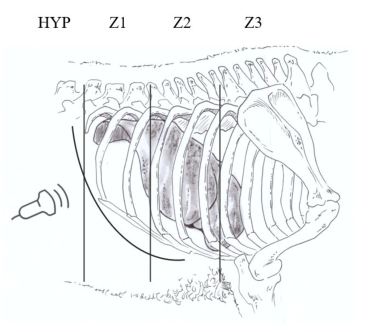Before conducting ultrasound testing, it is necessary to shave off the area between the right rib and the tail edge of the ipsilateral scapula of the sheep, and use an alcohol solution to remove surface oil and dirt before conducting sheep ultrasound testing. Use a micro convex high-frequency probe (6-10 MHz) for detection, with the sheep in a standing position, and perform a complete liver ultrasound examination starting from the right rib, from the 12th to the 5th intercostal space (IS), with each examination using longitudinal and transverse complete scans from the dorsal to ventral sides.
Measuring sheep with B-ultrasound machine
The scanning area is divided into three different scanning windows: Zone 1 (Z1), from the right rib to the 11th IS; Zone 2 (Z2) from the 10th IS to the 8th IS; Zone 3 (Z3) from the 7th IS to the 5th IS. The liver was also examined, and the probe was placed on the skull portion of the right rib (HYP). All detected hydatid lesions are always located and characterized according to WHO guidelines.
Sheep use B-ultrasound machine to detect the position of sheep liver

In the above figure: Liver region division used for developing rapid scanning programs. HYP: Perform liver scans based on suspected symptoms; Z1: Liver scan from the rib cage to the 11th rib cage; Z2: Liver scan between the 10th and 8th intercostal spaces; Z3: Liver scan from the 7th to the 5th intercostal space.
CL: Single room anechoic cystic lesion with uniform anechoic content. The cyst wall is not visible.
CE1: A uniformly anechoic cyst with uniform anechoic content or small internal echoes.
CE2: Cysts with internal partitions, sometimes honeycomb shaped
CE3: Unilocular cyst, which may indicate the presence of sub cysts.
CE4: Low echo and high echo matrices, resembling a wool ball in appearance.
CE5: Partial or complete calcification of the cyst wall.

Sheep liver lesions detected by ultrasound using a sheep B-ultrasound machine
Figure 4 Liver lesions detected by ultrasound: (B) Unilocular cyst, layered membrane detached from the cyst wall, may contain daughter cysts, transitional; (C) The thick calcified wall is arched, producing conical shadows and is inactive; (D) Liver abscess.








